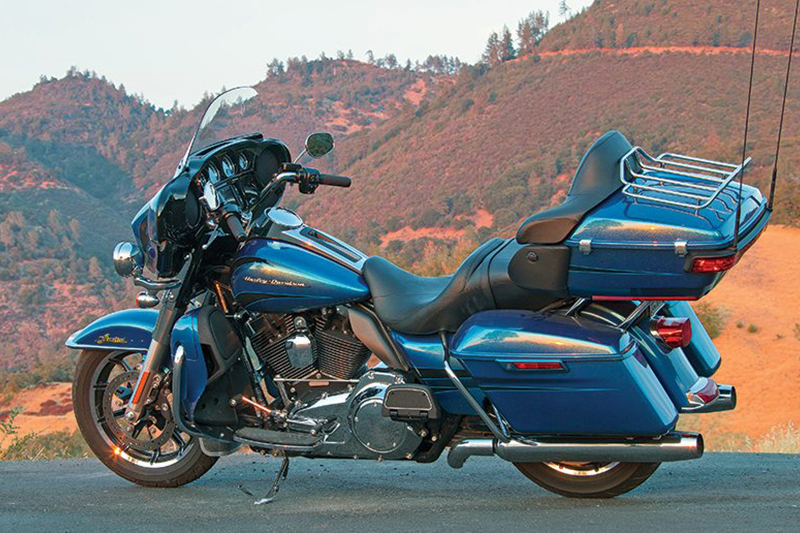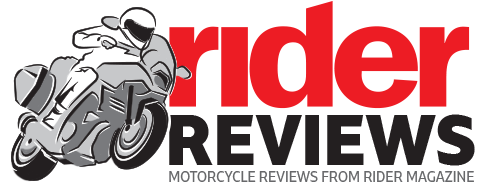2014 Harley-Davidson Ultra Limited

Road Test Review
In the right-here, right-now times we’re living in, much of what we buy is built and sold for the lowest possible price, or it’s made flashy and splashy just to get our attention. But as touring riders, we understand the value of refinement. We place high demands on our motorcycles, and we know that genuine quality is what endures over the long haul. Better design, fewer rough edges, more enjoyment.
That’s what Harley-Davidson’s Project Rushmore, a four-year, customer-driven effort to improve the Motor Company’s lineup, is all about. Product planners, designers and engineers teamed up to identify the changes that customers wanted most; time and effort was invested to make those changes, test them, refine them and gather more customer feedback; and noses stayed against the grindstone until everything was done right.
In last month’s Kickstarts, Editor-in-Chief Mark Tuttle gave an overview of the many changes implemented as part of Project Rushmore, everything from reshaped buttons to partial liquid cooling on several models. After riding the Touring models that received the most extensive upgrades, he came away impressed. At the top of the non-CVO heap is the 2014 FLHTK Ultra Limited (Electra Glide has been dropped from the name), a decked-out luxury tourer that has been all but transformed by Project Rushmore.
The hell-hath-frozen-over news for 2014 is the introduction of precision liquid cooling on the Twin-Cooled High Output Twin Cam 103 V-twin that powers the Ultra Limited and Tri Glide Ultra, and the Twin-Cooled Twin Cam 110 that powers the CVO Limited. Increasingly stringent emissions standards, as well as the need for higher and more consistent engine output and better heat management, means that liquid cooling on big twins was inevitable. Harley-Davidson stylists and engineers went to great lengths to conceal the Twin-Cooled system, tucking coolant ducts out of view beneath the fuel tank and cleverly hiding the twin radiators and thermostatically controlled fans inside the fairing lowers.
According to Matt Hoffmann, senior project engineer at Harley-Davidson, the percentage of total cooling accounted for by the Twin-Cooled system depends on operating conditions, with liquid cooling providing roughly 25 percent of total cooling at highway speeds and 85 percent of the total at idle. “Combining the effects of air and liquid cooling allows us to optimize the performance of the Twin-Cooled system and still maintain the look, sound and feel of our Twin Cam engine,” said Hofffman. And should the Twin-Cooled system spring a leak or the water pump fail, the engine will run with air-cooling alone to reach service under its own power.
Partial liquid cooling allowed a bump in the compression ratio from 9.6:1 to 10.1:1, and along with a new camshaft that optimizes low-end torque and a higher-flow airbox, Harley-Davidson claims a 10.7-percent torque increase over the standard Twin Cam 103. On Jett Tuning’s dyno, our 2014 Ultra Limited test bike belted out 95.0 lb-ft of torque at 3,700 rpm and 79.2 horsepower at 5,200 rpm at the rear wheel—11.5 percent and 16.3 percent higher, respectively, than the standard Twin Cam 103-equipped 2011 Road Glide Ultra (85.2 lb-ft of torque, 68.1 horsepower; Rider, September 2010). Close to the 5,800-rpm redline, the Twin-Cooled High Output 103’s torque and horsepower advantage is even greater, exceeding 20 percent. Near sea level along the California coast, that extra grunt can be felt with every twist of the throttle, and there’s less need to drop a gear for a quick pass or a steep incline. Just as impressive is the dramatic reduction in heat coming off the engine, especially on hot days or when stuck in stop-and-go traffic. Heat from the radiators exits through vents on the trailing edge of the fairing lowers, away from the rider. The Ultra Limited is still equipped with the Engine Idle Temperature Management System (EITMS), which can be used to turn off the rear cylinder fuel injector at idle when engine temperature is high.
Though more powerful and cooler running, the Twin-Cooled 103 has the same dimensions and architecture as before, with pushrods actuating two overhead valves per cylinder and hydraulic, self-adjusting lifters. The rubber-mounted motor shakes at idle and smoothes out under throttle, with motive force sent through a 6-speed overdrive transmission and belt final drive. Helical-cut gears and a heel-toe shifter make gear changes a quiet, easy affair. Replacing the cable-actuated clutch is a new hydraulic clutch that needs less maintenance, provides more consistent engagement and requires no additional effort, even though stronger clutch springs are used. The non-adjustable clutch lever still requires a firm pull, and I wish the gear position indicator didn’t go blank when the clutch is pulled in. The 6-gallon tank requires premium fuel, and during our 1,000-mile test we averaged 40.9 mpg.
The Limited’s steel frame and swingarm serve as a strong skeleton to support this 901-pound fully fueled machine, which weighs 16 pounds more than the 2009 Ultra Classic we last tested (Rider, November 2008). With small radiators and just 1.1 quarts of coolant, the Twin-Cooled feature accounts for only part of the weight increase. To better support all that weight, especially with the Batwing fairing bolted to the fork, the stanchions are now 49mm in diameter (up from 43.1mm), the triple clamps are stiffer and the steering stem has larger bearings. The fork has no adjustability, but the rear shocks are air-adjustable. Front and rear damping has been revised and the new Contrast Chrome Impeller cast-aluminum wheels are lighter and stiffer than their predecessors. The end result is more responsive handling and a more comfortable ride.
To increase the margin of safety, the Ultra Limited is equipped with H-D’s new Reflex Linked Brakes with ABS. For optimal low-speed control, the front and rear brakes operate independently below 20-25 mph. At higher speeds, the Reflex system becomes active; when either or both brake controls are used, a proportional control valve sends power to both front and rear brakes as needed. In practice, most riders won’t notice the difference, but they will surely benefit from shorter stopping distances, especially in emergencies. Each of the three 300mm discs are squeezed by 4-piston opposed calipers, and overall braking power is excellent. When the ABS engages there is some kickback at the lever and pedal, but the system operates smoothly without shuddering. The front rotors are now floating and have a more open design to showcase the Impeller wheel.
On touring motorcycles, comfort is king. Not only is engine heat lower thanks to the Twin-Cooled system, overall airflow around the bike has been improved. First introduced in 1969, the iconic Batwing fairing has been reshaped for a more dynamic, aggressive look and better aerodynamics. A new “splitstream” vent below the windscreen reduces pressure behind the screen and allowed the non-adjustable windscreen to be cut down by 3.25 inches for better visibility. At 65-75 mph, I felt only a small amount of wind at the top of my helmet, and it was quiet enough that I didn’t need to wear earplugs and was able to listen to the sound system clearly at about two-thirds of maximum volume. Extensive wind tunnel testing guided the Batwing redesign, which provides more hand coverage, as well as the shape of the fairing lowers and the new bullet-shaped turn signals. Closable vents in the lowers direct a large amount of air to the rider’s legs, and adjustable wind deflectors below the fairing block or direct air into the cockpit.
Sitting in the plush, deeply dished seat with my feet up on the large, rubber-insulated floorboards is like sitting in the lap of luxury, with plenty of legroom and no strain in my arms or back. My fiancée Carrie, a very discerning passenger, was tickled pink by the wider, longer pillion as well as the more supportive backrest, rating the Ultra Limited as one of the most comfortable motorcycles she’s ever ridden. The passenger armrests have been reshaped and the saddlebag guards and passenger audio controls have been repositioned, all in the name of comfort.
Other changes enhance comfort on a smaller scale. Reshaped buttons are easier to operate by feel; larger gauges with much wider numbers reduce eyestrain; One-Touch latches simplify opening and closing the Tour-Pak, saddlebags, jukebox media compartment, fuel door and slipstream vent. The restyled Tour-Pak and saddlebags are sleeker in appearance, yet both have slightly more capacity (4.7 cubic feet total), and the Tour-Pak rack and luggage liners are standard.
The all-new Harmon Kardon-made Boom! Box 6.5GT infotainment system integrates audio, communications and navigation in a single, easy-to-use module that includes a 6.5-inch color touch screen housed inside the fairing. Four large, well-marked control buttons flank the screen and five-way joysticks on each handlebar switchpod control the system. Next to the touch screen is a compartment with a USB connector and a foam holder for a smartphone or MP3 player. The Boom! Box 6.5GT’s suite of features is too extensive to list here, but it does pretty much everything you could ask of a system like this. I found it easy to use, though there is a learning curve; audio prompts provide guidance when you need it. By pairing my iPhone via Bluetooth and using the optional factory headset ($189.95), I was able to use voice commands to tune the radio, place a phone call and navigate to a particular location. Overall, sound quality from the four-speaker, 25-watts-per-channel system was first-rate.
As part of Project Rushmore, Harley-Davidson’s own marching orders were, “Respect the heritage, but move it forward.” Every change to the Ultra Limited makes it a better motorcycle. Some make it more stylish, such as the character lines on the fairing, saddlebags and Tour-Pak or the low-profile front fender that better shows off the Impeller wheels, but most make it more enjoyable to ride. It runs stronger, cooler and with better airflow. It is more comfortable, easier to operate and has a comprehensive infotainment system. The Daymaker LED headlight and fog lights provide excellent nighttime illumination, and heated grips and cruise control are standard. The total impact of the new Ultra Limited adds up to more than the sum of its many refinements. Bar none, this is one of the best Harley-Davidsons we’ve ever tested.
